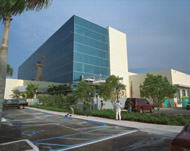|
FEATURE ARTICLE, JUNE 2004
DELIVERING YOUR PROJECT ON SCHEDULE
AND ON BUDGET
How to avoid the “ready, fire, aim” real estate
phenomenon.
Chuck Winstead
 |
|
Winstead
|
|
Miami International Airport is the Number 1 airport in the
United States for international freight. The airport has more
scheduled non-stop cargo flights to Latin America and the
Caribbean than the airports in Orlando and Tampa, Florida;
Houston; New Orleans; Atlanta; and New York City (John F.
Kennedy International) combined. But despite its reputation
as a cargo hub, historically contractors at the airport have
struggled to build critical new facilities on time and on
budget.
In 1999, a private company made plans to develop a $110 million,
564,000-square-foot cargo complex for Lan Chile Cargo Airlines
and Fine Air Services near the Miami International Airport.
When complete, the facility would handle nearly one-third
of the total air-freight shipped between North and South America.
With Federal Aviation Administration security requirements,
110,000 square feet of refrigerated warehouse space and an
attached 50,000-square-foot Class A office being used as a
corporate headquarters by one of the tenants, the project
had every opportunity to fail. But a unique approach to construction
and development helped the facility get built on time and
under budget.
In order to avoid the work stoppages and budget overruns that
had plagued previous projects, several steps were taken that
can offer guidelines for complex development projects in cities
throughout the Southeast.
Previous projects had been started before construction planning
was complete and before the right team of contractors, architects
and engineers had been assembled. They were examples of the
“ready, fire, aim” phenomenon that often occurs
on major urban construction projects. The phenomenon is typically
the result of excitement generated by large projects, where
the rush to build overwhelms the prudence that must be associated
with developing multi-million dollar structures.
 |
|
For the 564,000-square-foot
cargo complex for Lan Chile Cargo Airlines and
Fine Air Services in Miami, the contractor, owners,
architects and engineers spent 7 months planning,
assessing challenges and assembling the right
team of subcontractors before beginning the project,
allowing it to be completed under budget and in
record time.
|
|
“Ready, fire, aim” most often troubles those who
move outside of their comfort zones to build unique projects
in challenging locations: a non-profit organization proposing
a landmark building; a philanthropist considering a legacy
landmark; a suburban office developer working on an intown
parcel; a municipality building a huge public facility; or
an investor with a massive stake in a complex, mixed-use high-rise.
Those proposing unique buildings in infill locations often
forget to ask critical questions:
• What is the right team? Every market is different,
and it is critical to assemble a team of lead contractors
and partners that understand the vagaries of the industry
in the specific submarket. Look for team members that have
succeeded in the market before and have existing relationships
with key civic leaders.
• Do I need a third party to get me on the right track?
When building beyond their experience, owners and developers
should seek expertise that is not trying to sell architecture
or contracting services. Having an independent voice involved
early in the project will involve minimal cost, while also
providing a realistic picture of what to expect and how to
plan. An independent expert can also mediate when mid-stream
challenges arise that pit professionals against one another.
• How much time should be dedicated to planning? For
the Lan Chile Cargo Airlines and Fine Air Services in Miami,
the contractor, owners, architects and engineers spent 7 months
planning, assessing challenges and assembling the right team
of subcontractors before beginning the project, allowing it
to be completed under budget and in record time.
• Who are the key audiences? When a large project is
announced, various groups often come calling with “wish
lists.” This can include anything from air-conditioning
for a local school to jobs for local residents. Pre-selling
and engaging in meaningful dialogues with these groups is
often a must. Neighborhood groups, unions, city officials,
regional officials and environmentalists often expect to be
heard and can cause problems if they are not considered early
on.
 |
|
In order to comply with Federal
Aviation Administration security requirements,
a specific set of steps were taken to ensure that
projects near the Miami International Airport
were successful.
|
|
• What can derail this project? It behooves all parties
involved to consider scenarios that could stop or delay the
project. Brainstorm these scenarios and develop a crisis plan
in case they occur. Be sure to consider worker safety issues,
environmental policies, site-specific challenges, political
sensitivities and other non-design issues. Remember that in
urban areas, private deals will have “public” elements:
even a privately financed, privately developed office tower
impacts surrounding public spaces, utilities and the crowded
urban street grid.
For investors, developers, municipalities and owners that
are considering complex projects in urban areas, there is
only one cure for “ready, fire, aim” — thoughtful
planning before hiring the first professional. Consulting
an outside expert — and one without a vested interest
in “selling up” for other services — is the
wisest initial investment owners, developers and investors
can make.
Chuck Winstead is a principal with Gellerstedt Consulting,
an Atlanta-based real estate consulting company.
©2004 France Publications, Inc. Duplication
or reproduction of this article not permitted without authorization
from France Publications, Inc. For information on reprints
of this article contact Barbara
Sherer at (630) 554-6054.
|
